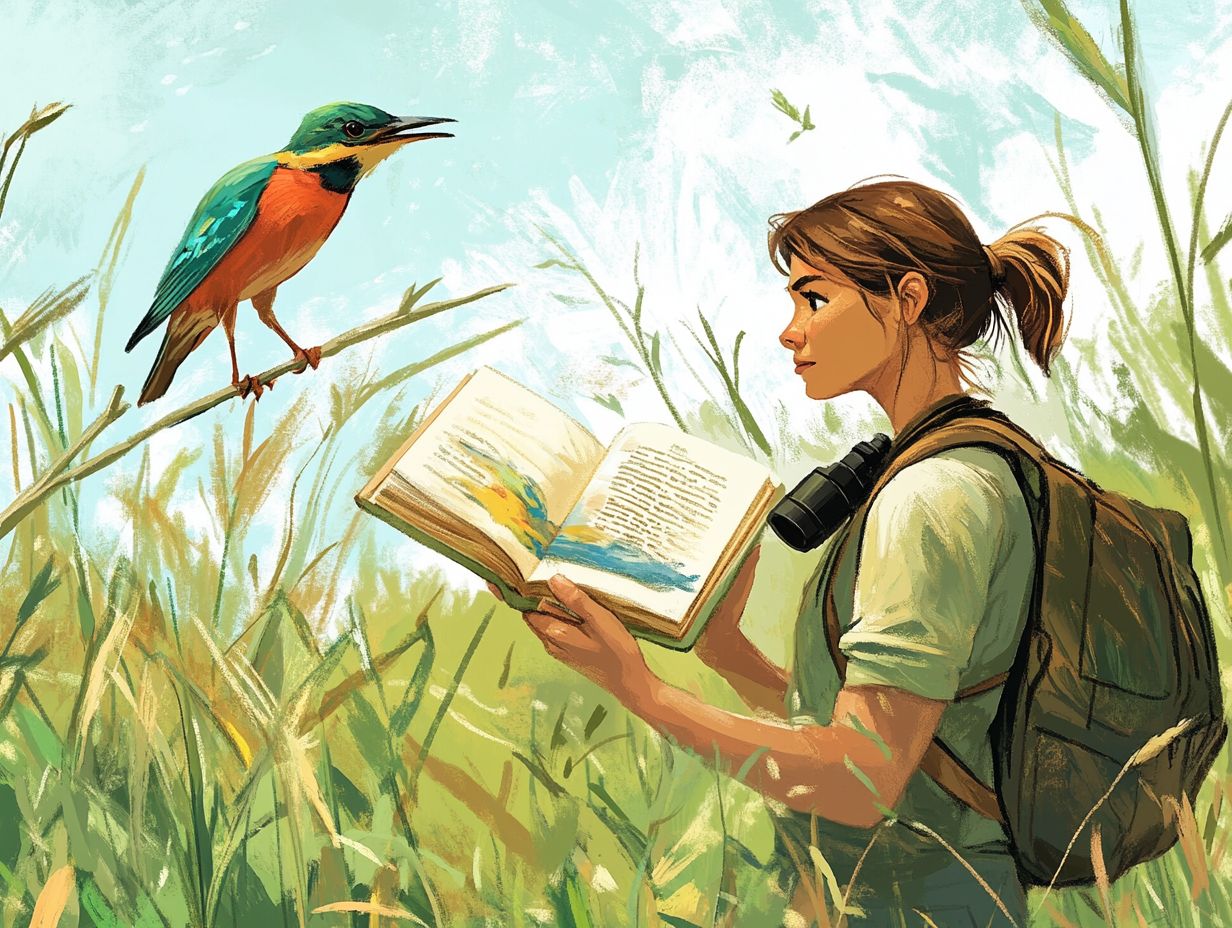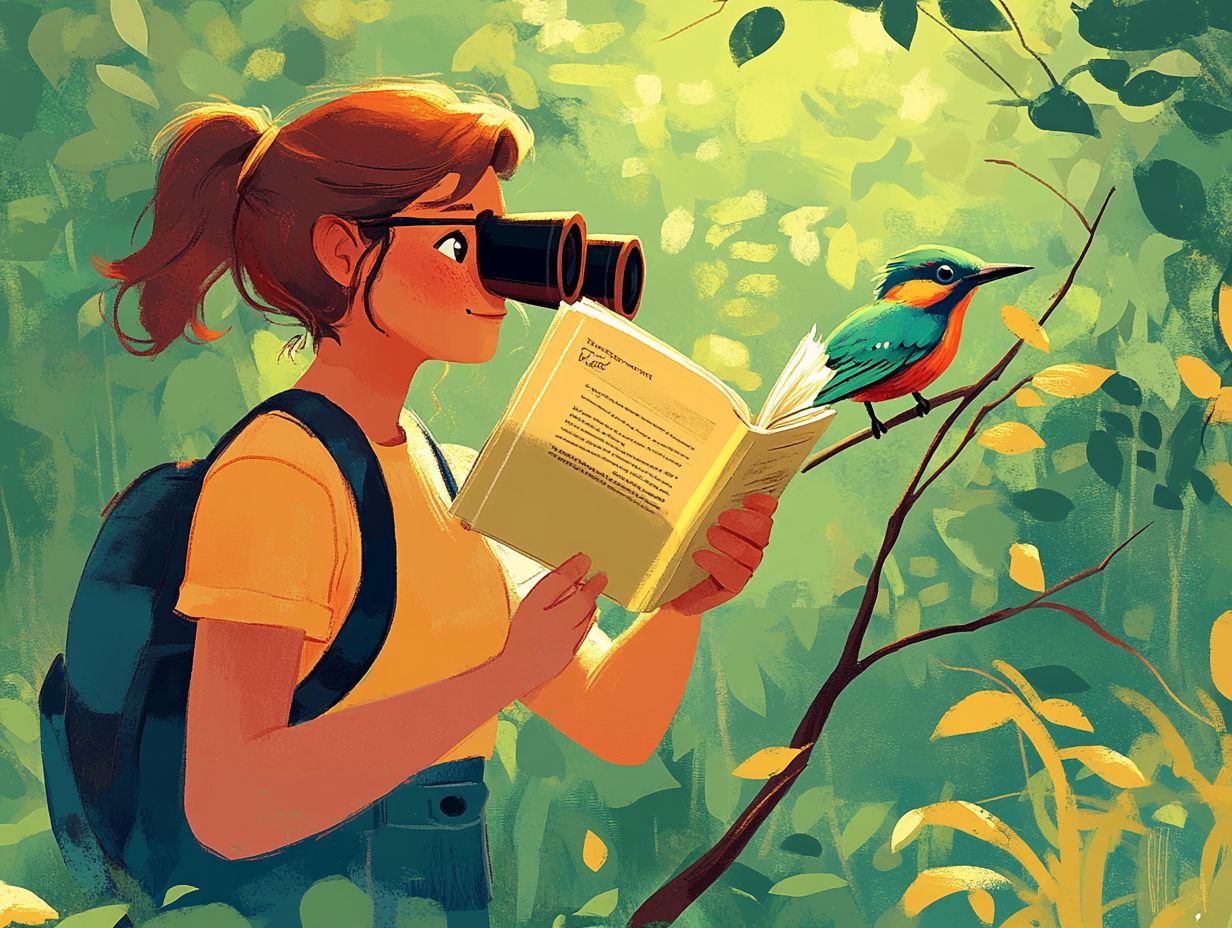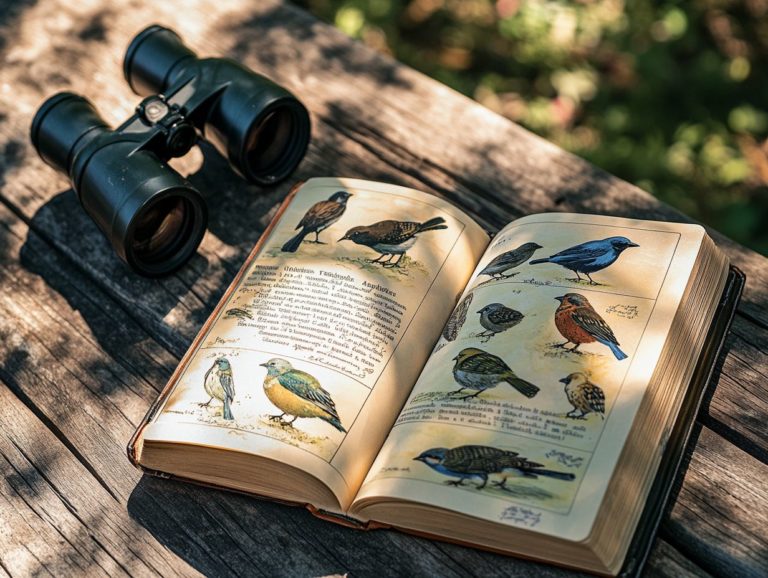Field Guides: Bridging Knowledge Gaps in Birding
Field guides are your ultimate companions for diving into the thrilling world of birdwatching! They refine your species identification skills, deepen your appreciation for bird behavior and habitats, and provide practical tips for effective observation.
Whether you cherish the tactile experience of print guides or prefer the convenience of digital versions, there s a perfect fit for every birding enthusiast. This article explores the benefits of field guides, offers guidance on choosing the right one, and shares tips on creating your own, ensuring your birding adventures are as enriching and rewarding as possible. Consider exploring various resources like those from Sibley and Peterson to enhance your experience.
Contents
Key Takeaways:

- Field guides enhance bird species identification and observation skills for birders of all levels.
- They provide valuable information on bird behavior and habitat, allowing for a deeper understanding and appreciation of birds, including those found in locations like Eastport, Maine.
- When choosing a field guide, consider factors like portability, level of detail, and personal preference for the most effective use in the field.
What are Field Guides?
A field guide is an essential tool for birding enthusiasts, offering a wealth of information about various birds, including their habitats, behaviors, and physical traits.
Field guides serve as a reference for identifying species and enhance your birdwatching experience in their natural settings.
By turning to reputable sources like Sibley or Peterson, you can accurately pinpoint species such as the Common Gull or the Virginia Rail, refine your observation techniques, and keep detailed records of your findings.
Mastering the use of these guides often leads to a deeper understanding of bird life and fosters a more personal connection to the art of birdwatching, particularly during the enchanting twilight hours.
Benefits of Using Field Guides in Birding
Utilizing field guides in birding brings a wealth of benefits that significantly enrich your experience and boost your observational accuracy, enabling you to fully engage with the captivating world of birds.
With the right field guide in hand, you can enhance your species identification skills, making it simpler to spot and recognize various birds like the Northern Mockingbird or the Northern Shovelers.
These guides also help you keep effective records, allowing you to maintain a life list of your observations a rewarding aspect of your birding journey, making it easier to track the bird species you ve encountered.
Enhancing Identification and Observation Skills
Field guides are essential for enhancing your identification and observation skills, offering valuable insights as well as the tools necessary to recognize various birds in their natural habitats. For a comprehensive resource, check out Field Guides: Navigating the World of Birds.
These invaluable resources typically feature detailed illustrations and descriptions of physical traits, including plumage color, size, and unique markings. By honing in on these visual cues, you can sharpen your ability to spot different birds like the Northern Mockingbird and Northern Shovelers while reducing the likelihood of confusing them with similar species.
Understanding the songs and calls of birds can greatly enhance your birding experience. Recognizing these auditory signals can sometimes be easier than identifying species visually, especially when you’re in the field with your binoculars ready. Moreover, becoming familiar with different bird habitats such as wetlands, forests, and grasslands will further assist you in identification, particularly in places like Rocky Mountain National Park and Waterton Lakes NP. This understanding allows you to predict where certain species are likely to be found, significantly boosting your chances of successful sightings.
Are you ready to take your birdwatching to the next level? Dive into your birding adventure today and discover the magic of field guides!
Learning About Bird Behavior and Habitat
Understanding bird behavior and habitat is essential for any birder. Field guides offer invaluable insights that equip you to appreciate the nuances of avian life.
These resources explore the fascinating ways different bird species interact with their surroundings. They shed light on behaviors such as foraging techniques, nesting preferences, and courtship displays. For example, your field guide might reveal the intricate courtship displays of Cassin’s Vireo. You may also discover the acrobatics of a Chickadee as it dances among branches, expertly gleaning insects from leaves.
When you witness the elaborate courtship rituals of the American Woodcock complete with its spectacular aerial display you ll find it even more captivating through the guide’s descriptions of its grassland habitat or the nearby wetlands.
By grasping these behaviors in context, you can elevate your observation experiences, nurturing a deeper connection with the natural world around you.
Types of Field Guides

Field guides come in many formats, each offering distinct advantages. As a birding enthusiast, you can elevate your species identification skills by understanding the importance of field guides in bird watching, whether you prefer the tactile experience of print from Hyde Brothers Booksellers or the convenience of digital options like eBird and Merlin Bird ID.
Print vs Digital Guides
When choosing between print and digital guides, like those from National Geographic or Audubon, consider your personal preferences. Both formats provide valuable insights for identifying bird species.
Print guides, such as Peterson Field Guides or The Sibley Guide to Birds, often boast high-quality illustrations and detailed information about various species. These resources, including field guides as your birdwatching companion, can be invaluable for serious birders, offering a tactile experience that is comforting during field observations, especially in remote areas where your digital devices might struggle for signal.
Digital platforms like Merlin Bird ID and eBird offer impressive accessibility and interactivity. They allow you to swiftly search for species and track your sightings with ease. However, be mindful of potential drawbacks like battery dependency and distractions from notifications.
Ultimately, your choice will depend on your environment, comfort level with technology, and desire for personalization in your birding experience.
Choosing the Right Field Guide
Selecting the perfect field guide is crucial. It can transform your birding adventures into something extraordinary and enhance your ability to understand bird behavior and identify various species accurately.
Factors to Consider
When selecting a field guide, several factors are essential. Consider the areas the guide covers to ensure it aligns with your birding aspirations and personal preferences.
The areas the guide covers are crucial; different guides concentrate on specific regions, making it easier for you to identify local species. Don’t overlook the importance of ease of use a clear layout and intuitive organization can significantly enhance your birdwatching experience.
The level of detail in descriptions, such as behavioral traits and vocalizations, offers invaluable insights that enrich your understanding. Supplemental resources like apps or online databases can enhance your overall knowledge.
As you explore various options, quickly think about your goals and what aspects of birding excite you most. This reflection will help you select the perfect guide to support your journey.
Using Field Guides in the Field
To successfully utilize field guides while birdwatching, you need effective strategies. These sharpen your observation skills, ensure precise record-keeping, and enhance your overall birding experience, regardless of your experience level.
Tips for Effective Use

To elevate your birding experience with field guides, consider employing strategies that refine your observation skills, such as using quality binoculars, and streamline the identification process. Binoculars are optical devices used to see distant objects clearly.
- Start by crafting a checklist of local birds you aspire to see. Mark off each species as you spot them to effectively track your observations. This simple method enhances your focus and adds a sense of accomplishment.
- Utilizing binoculars with intention can markedly enrich your outing. Practice panning slowly to avoid startling the birds while maintaining a sharp focus on your subject.
- Joining the birding community can enhance your adventures. Engaging on platforms like Twitter or eBird allows you to connect with fellow enthusiasts who share their discoveries, tips, and local hotspots, fostering relationships that deepen your knowledge and enjoyment in the field.
Creating Your Own Field Guide
Creating your own field guide is an exciting way to document your birding adventures! It enables you to document your observations and tailor your birding experience, whether in a physical notebook or through digital applications, through meticulous organization and thoughtful documentation.
How to Document and Organize Birding Information
Effective documentation and organization of your birding information are essential for crafting a personal field guide that captures your unique experiences and observations.
By meticulously recording each sighting taking note of the date, location, weather conditions, and specific behaviors you can weave together a rich narrative of your encounters. Establishing a consistent structure for these entries not only helps you recall the distinct qualities of each species but also enhances your personal reflections.
Incorporating notes about your emotional reactions or significant moments will deepen your connection to nature. Meanwhile, organizing your collected data efficiently allows for detailed tracking of patterns and trends over time. This practice amplifies the joy of birding, nurturing a sense of accomplishment and a growing appreciation for the avian world.
Frequently Asked Questions
Here are some common questions about field guides and how they can enhance your birding experience:
What is a field guide?
A field guide is a book or resource that provides information on identifying and learning about different species of birds in their natural habitats.
How can a field guide help bridge knowledge gaps in birding?

A field guide can help bridge knowledge gaps in birding by providing detailed descriptions, illustrations, and distribution maps of various bird species, as well as information on their behavior and habitat.
Are all field guides the same?
No, field guides can vary in terms of the types of birds they cover, the level of detail provided, and the layout and design. It is important to find a field guide that best suits your needs and preferences.
Can I use a field guide for all types of birding?
While field guides are a valuable tool for general birding, there are also specialized guides for specific regions or types of birds, such as waterfowl or raptors. It is important to have a variety of field guides to cover all your birding interests.
Do I need to be an expert to use a field guide?
No, field guides are designed to be user-friendly and accessible for birders of all levels. They often include introductory chapters on bird identification and terminology to help beginners.
Can I rely solely on a field guide for bird identification?
While field guides are a great resource, it is important to also supplement your knowledge with other resources such as birding apps, websites, and experienced birders. Combining different sources can help confirm identifications and enhance your understanding of bird species.






